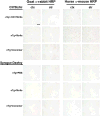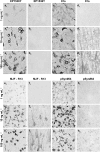Sensitivity and specificity of phospho-Ser129 α-synuclein monoclonal antibodies
- PMID: 29888794
- PMCID: PMC6031478
- DOI: 10.1002/cne.24468
Sensitivity and specificity of phospho-Ser129 α-synuclein monoclonal antibodies
Abstract
α-Synuclein (α-syn) is an abundant presynaptic protein that is the primary constituent of inclusions that define Lewy body diseases (LBDs). In these inclusions, α-syn is phosphorylated at the serine-129 residue. Antibodies directed to this phosphorylation site are used to measure inclusion abundance and stage disease progression in preclinical models as well as in postmortem tissues in LBDs. While it is critical to reliably identify inclusions, phospho-specific antibodies often cross-react with nonspecific antigens. Four commercially available monoclonal antibodies, two from rabbits (clones EP1536Y and MJF-R13) and two from mice (81a and pSyn#64), have been the most widely used in detecting pS129-α-syn inclusions. Here, we systematically evaluated these antibodies in brain sections and protein lysates from rats and mice. All antibodies detected pS129-α-syn inclusions in the brain that were induced by preformed α-syn fibrils in wild-type rats and mice. Antibody titrations revealed that clones EP1536Y and 81a comparably labeled inclusions in both the perikarya and neuronal processes in contrast to clones MJF-R13 and pSyn#64 that incompletely labeled inclusions at various antibody concentrations. Except for EP1536Y, the clones produced nonspecific diffuse neuropil labeling in α-syn knockout mice as well as mice and rats injected with monomeric α-syn, with some nonspecific staining titrating with pS129-α-syn inclusions. By immunoblot, all the clones cross-reacted with proteins other than α-syn, warranting caution in interpretations of specificity. Clone EP1536Y uniquely and robustly detected endogenous pS129-α-syn in highly soluble protein fractions from the mouse brain. In summary, EP1536Y had the highest sensitivity and specificity for detecting pS129-α-syn.
Keywords: Lewy bodies; Lewy neurites; NACP; SNCA.
© 2018 Wiley Periodicals, Inc.
Figures







References
-
- Abdelmotilib H, Maltbie T, Delic V, Liu Z, Hu X, Fraser KB, Moehle MS, Stoyka L, Anabtawi N, Krendelchtchikova V, Volpicelli-Daley LA, West A. alpha-Synuclein fibril-induced inclusion spread in rats and mice correlates with dopaminergic Neurodegeneration. Neurobiol Dis. 2017;105:84–98. - PMC - PubMed
Publication types
MeSH terms
Substances
Grants and funding
LinkOut - more resources
Full Text Sources
Other Literature Sources
Molecular Biology Databases
Miscellaneous

